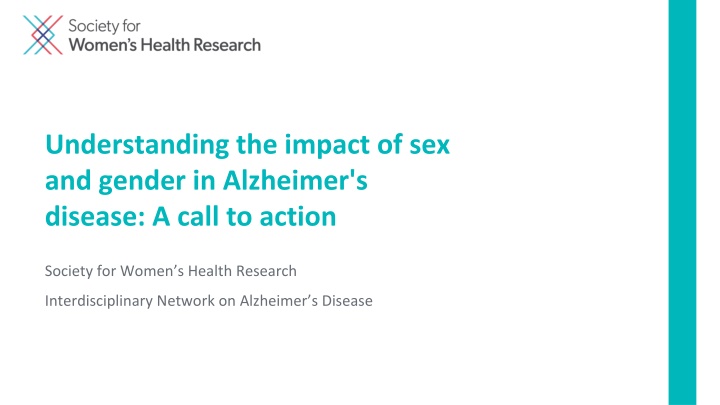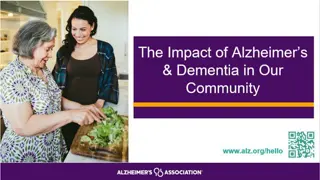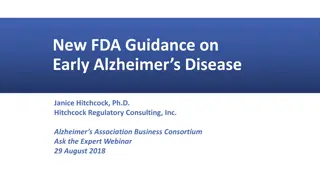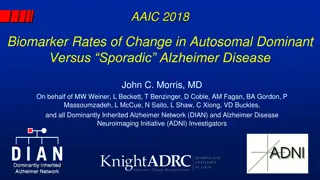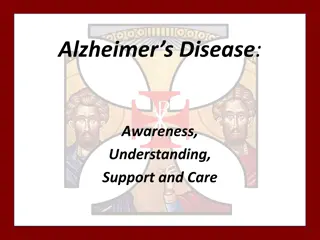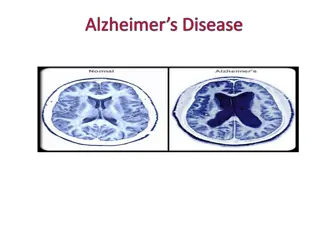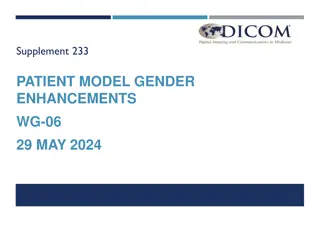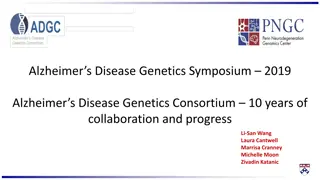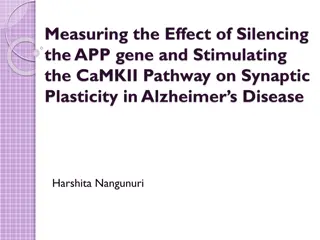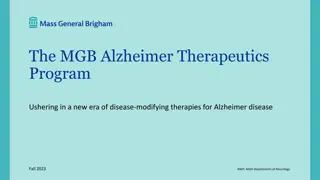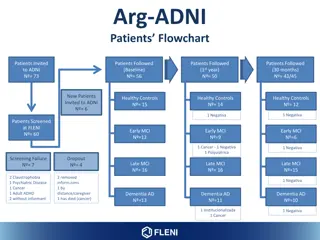Impact of Sex and Gender in Alzheimer's Disease
This content delves into the significance of sex and gender in Alzheimer's disease, emphasizing the mission of exploring, understanding, and leveraging these factors for informed prevention and treatment. It also highlights the work of the Society for Women's Health Research and their interdisciplinary networks in advancing research on biological differences in disease.
Download Presentation

Please find below an Image/Link to download the presentation.
The content on the website is provided AS IS for your information and personal use only. It may not be sold, licensed, or shared on other websites without obtaining consent from the author.If you encounter any issues during the download, it is possible that the publisher has removed the file from their server.
You are allowed to download the files provided on this website for personal or commercial use, subject to the condition that they are used lawfully. All files are the property of their respective owners.
The content on the website is provided AS IS for your information and personal use only. It may not be sold, licensed, or shared on other websites without obtaining consent from the author.
E N D
Presentation Transcript
Understanding the impact of sex and gender in Alzheimer's disease: A call to action Society for Women s Health Research Interdisciplinary Network on Alzheimer s Disease
SWHR: WHO WE ARE The Society for Women s Health Research (SWHR) is a national nonprofit dedicated to promoting research on biological differences in disease and improving women s health through science, policy, and education.
SWHR INTERDISCIPLINARY NETWORKS SWHR brings together researchers, clinicians, and other stakeholders to work collaboratively on multiyear projects to: Assess the current state of the science Identify knowledge gaps and unmet needs in research and policy Develop recommendations to improve research, diagnosis, treatment, and access to quality care Disseminate the findings broadly to the public, policymakers, and scientific community
INTERDISCIPLINARY NETWORK ON ALZHEIMER S DISEASE MISSION: To explore, understand, and leverage the scientific basis of the roles of sex and gender in Alzheimer s disease to inform prevention and treatment, providing guidance for research, clinical trials, and policy.
CURRENT MEMBERS Pauline Maki, PhD, University of Illinois (Chair) Michelle Mielke, PhD, Mayo Clinic (Co-Chair) Lisa Barnes, PhD, Rush University Jill Goldstein, PhD, Harvard University Kejal Kantarci, MD, MS, Mayo Clinic Neelum T. Aggarwal, MD, Rush University Elizabeth Mormino, PhD, Stanford University Haung Yu, PhD, Columbia University
GLOBAL PREVALENCE OF ALZHEIMERS DEMENTIA 5.7 million American adults 47 million adults worldwide Over Active Bladder 2/3 are women 5thleading cause of death for women 8thleading cause of death for men 2018 Alzheimer's Disease Facts and Figures. Alzheimer's Association QuickStats: Number of Deaths from 10 Leading Causes,* by Sex National Vital Statistics System, United States, 2015. CDC. Alzheimer's & Dementia: Global Resources. Alzheimer s Association.
ECONOMIC BURDEN OF ALZHEIMERS DEMENTIA IN U.S. $186B $277B $20T Covered by Medicare and Medicaid Over Active Bladder Total cumulative costs by 2050 Total AD care costs in 2018 $60B $341,840 $15T Out-of-pocket costs Lifetime cost for individual in Medicare and Medicaid 2018 Alzheimer's Disease Facts and Figures. Alzheimer s Association
The AD Network prioritized 12 areas for future research in the following categories: Clinical Neurodevelopment and genes diagnostics and therapeutics disease mechanisms clinical diagnostics and therapeutics neurodevelopment and genetic risks epidemiology, socioeconomic, and lifestyle factors Sex- and gender- specific risks Epidemiology, socioeconomic, and lifestyle factors Disease mechanisms These areas directly affect future progress in prevention, treatment, clinical trial design, and public policy.
PRIORITY AREAS FOR FUTURE RESEARCH 1. The extent to which findings of sex and gender differences in AD are due to differences in longevity, survival bias, and comorbidities 2. Potential sex-specific risk factors for AD (e.g., oophorectomy, menopause, pregnancy, androgen- deprivation therapy, and testosterone loss) across the lifespan 3. The influence of estrogens and hormone therapy on brain function and AD risk in light of discrepancies in the clinical literature 4. Potential sex differences in genetic risk factors for AD (e.g., APOE, x-linked, common variants, autosomal dominant mutations, etc.) 5. Sex and gender differences in AD risk factors that are observed in both sexes (e.g., cardiovascular disease, diabetes, education, depression, etc.) across the lifespan 6. Sex differences in AD progression and the trajectory of change in cognitive function, neuroimaging, CSF, and blood-based biomarkers of AD 7. The effects of sex differences in brain development on sex differences in brain aging and, ultimately, AD pathology and dementia 8. The effects of sex and gender in risk factors, disease progression, and biomarkers in racial and ethnic subgroups, especially in African Americans and Hispanics/Latinos, and how this informs differential risk 9. The factors involved in the secular changes (e.g., societal, political) and geographical variation in estimates of sex differences in AD 10. Gender differences in caregiving and how the burden of caregiving influences AD risk 11. Sex and gender differences in developing AD therapeutics, from preclinical to clinical studies, and in the design of clinical trials 12. The effects of sex and gender differences on the clinical detection, diagnosis, management, and treatment of AD for both sexes
The extent to which findings of sex and gender differences in AD are due to differences in longevity, survival bias, and comorbidities What we know: Age is the major risk factor for AD Women live longer than men More women than men will develop AD during their lifespan What we don t know: The biological and sociocultural differences between the sexes that may influence differences in longevity and survival bias
Potential sex-specific risk factors for AD across the life span What we know: Early surgical removal of the ovaries is associated with cognitive decline Hypertensive pregnancy disorders (HPD) are associated with an increased risk of brain atrophy later in life What we don t know: What explains the increased AD risk in women with early surgical menopause (decreases in sex steroid hormones or other factors?) Whether common underlying factors increase the risk of both HPD and AD, or whether HPD itself is an independent risk factor for AD
The influence of estrogens and hormone therapy on brain function, and AD risk in light of discrepancies in the clinical literature What we know: Verbal memory decreases during the transition from premenopause to postmenopause - Change may resolve in the early postmenopausal period Hormone therapy (HT) has neutral effects on cognition in early postmenopause Findings on HT and dementia are mixed What we don t know: How HT influences cognition and AD risk The causes of the discrepancies in current HT findings How HT influences AD biomarkers
Potential sex differences in genetic risk factors for AD What we know: The 4 allele of the APOE gene is the strongest genetic risk factor for late-onset AD Women with APOE 4 have an increased risk of developing AD compared to women without APOE 4 and men with and without APOE 4 What we don t know: The mechanisms underlying the interaction between sex and APOE for AD risk Whether other genetic AD risk factors are stronger for women than men or vice versa Whether genes on the X or Y chromosomes effect AD risk
Sex and gender differences in AD risk factors that are observed in both sexes across the lifespan What we know: AD risk factors that differentially affect women and men include: o Cardiovascular disease o Hypertension o o o Diabetes Education level Depression Cardiovascular risk factors occur at earlier ages in men Some risk factors are more frequent in one sex (e.g., women have had less access to education and have a higher prevalence of depression) Men who have never married or are widowed have a greater risk of developing AD compared to women who have never married or are widowed What we don t know: How development of risk factors over the lifespan differentially affect AD risk for women and men Which modifiable risk factors are strongest for the development of AD in each sex
Sex differences in AD progression and the trajectory of change in cognitive function, neuroimaging, CSF, and blood-based biomarkers What we know: Women with mild cognitive impairment (MCI) show greater brain atrophy rates and greater cognitive and clinical decline than men AD pathology is more likely to be expressed clinically as dementia in women Women with the same amount of AD pathology as men show more severe clinical symptoms of AD What we don t know: Why women with MCI show greater decline than men Why women are more vulnerable to AD pathology than men
The effects of sex differences in brain development on sex differences in brain aging and, ultimately, AD pathology and dementia What we know: The female vulnerability for major depressive disorder and cardiovascular disease both risk factors for AD begins in fetal development Sex steroid hormones have organizational effects on the brain that contribute to sex differences in cognition What we don t know: How sex differences in brain development ultimately contribute to AD pathology and dementia
The effects of sex and gender in risk factors, disease progression, and biomarkers in racial and ethnic subgroups, especially in African Americans and Hispanics/Latinos, and how this informs differential risk What we know: African Americans and Hispanic/Latinos are 1.5 to 2 times more likely to be diagnosed with AD or related dementias than European Americans Minority populations are underrepresented in AD research studies, including clinical trials and biomarker studies What we don t know: Whether the increased AD risk is uniform across both sexes in minority populations Whether there are sex and gender differences in risk factors, disease progression, or biomarkers in minority populations
The factors involved in the secular changes (e.g., societal, political) and geographical variation in estimates of sex differences in AD What we know: In some regions/countries, women appear to be at greater risk of AD at older ages The experience of women and men in World Wars and political conflicts have historically differed both within and across counties In the past century, women have had fewer education and job opportunities What we don t know: Whether the historical experiences of women and men in political conflicts differentially impact AD risk (e.g., effects of stress, famine, survival in wars) At what age these factors exert their maximal effect on each sex Whether low socioeconomic status and job attainment pose similar AD risk for women and men
Gender differences in caregiving and how the burden of caregiving influences AD risk What we know: Women make up about 60% of family caregivers - Rates are even higher for Hispanics and African Americans Female caregivers report a twofold higher level of caregiver burden compared to male caregivers There are gender differences in caregiving responsibilities - Women provide more routine assistance; men use their networks for help Caregiving is associated with elevated levels of cortisol and impaired attention and executive function What we don t know: How gender differences in caregiver responsibilities may impact AD risk The sex-specific risk of developing cognitive impairment or dementia for spousal caregivers vs. non-caregiver spouses
Sex and gender differences in developing AD therapeutics, from preclinical to clinical studies, and in the design of clinical trials What we know: The 1993 NIH Revitalization Act required that women be included in all clinical studies and that trials be designed to permit analysis of different effects in women In 2016, NIH began requiring researchers to factor in sex as a biological variable to the design, analyses, and reporting in vertebrate animal and human studies What we don t know: Although analyses of clinical trial data generally include sex as a variable, equivocal treatment effects may not be reported in publications, making it difficult to know how to compare this information between studies
Sex and gender differences in developing AD therapeutics, from preclinical to clinical studies, and in the design of clinical trials What we know: The FDASIA 907 Action Plan outlines specific actions to enhance recruitment, participation and enrollment of subgroups in clinical trials For Phase III trials, NIH mandates a plan for analyses on intervention by sex/gender, racial, and/or ethnic groups to detect differences in effect AD is more prevalent in women, and clinical trial participation is increasingly representative of this demographic What we don t know: Why minority women remain disproportionately underrepresented in clinical trials
The effects of sex and gender differences on the clinical detection, diagnosis, management, and treatment of AD What we know: The diagnosis of amnestic mild cognitive impairment (aMCI) and AD relies on tests of verbal memory (e.g., memory for word lists, stories) There is a lifelong female advantage in verbal memory Among those with aMCI, women perform better than on tests of verbal memory despite having the same level of AD-related pathology What we don t know: Whether the female advantage in verbal memory delays aMCI diagnosis for women, possibly limiting opportunity for early intervention Whether using sex-specific cutoff scores to detect impairment in verbal memory tests would improve diagnostic accuracy
CONTACT Pauline Maki, PhD, University of Illinois (Chair) pmaki1@uic.edu Michelle Mielke, PhD, Mayo Clinic (Co-Chair) Mielke.Michelle@mayo.edu Rebecca Nebel, PhD, SWHR, Director of Scientific Programs rebecca@swhr.org For more information, visit www.swhr.org. Follow us on Twitter @SWHR.
